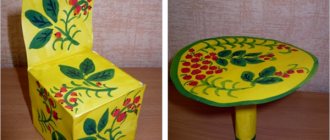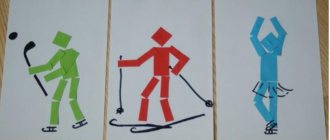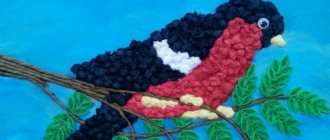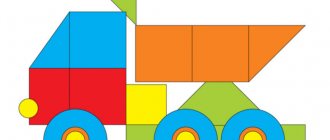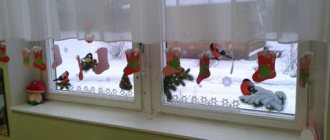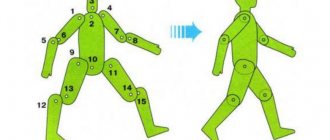October
Lesson 12. Drawing “Golden Autumn”
Program content.
Teach children to depict autumn. Practice drawing a tree, trunk, thin branches, autumn foliage. Strengthen technical skills in painting with paints (dip the brush with all its bristles into a jar of paint, remove an extra drop on the edge of the jar, rinse the brush well in water before adding another paint, blot it on a soft cloth or paper napkin, etc.). Lead children to figurative transmission of phenomena. Foster independence and creativity. Induce a feeling of joy from bright, beautiful drawings.
Lesson 13. Modeling “Mushrooms”
Program content.
Strengthen children's ability to sculpt familiar objects, using previously learned sculpting techniques (rolling clay with straight and circular movements, flattening with palms, sculpting with fingers) to refine the shape. Lead to a figurative assessment of work.
Lesson 14. Drawing “Fairytale tree”
Program content.
Teach children to create a fairy-tale image in a drawing. Practice the ability to convey the correct structure of a tree. Learn to paint. Develop imagination, creativity, speech.
Lesson 15. Application “Decoration of a handkerchief”
Program content.
Teach children to identify the corners and sides of a square. Reinforce knowledge of round, square and triangular shapes. Practice choosing color combinations. Learn to transform shapes by cutting a square into triangles, a circle into semicircles. Develop compositional skills and color perception.
Program content.
Teach children to make a simple pattern from elements of folk ornament on a strip of paper. Develop color perception, figurative ideas, creativity, imagination.
Lesson 17. Modeling “Treats for dolls”
Program content.
To develop children's imaginative ideas and the ability to choose the content of an image. Learn to sculpt a selected object using previously learned techniques. Continue to develop the ability to work accurately. To cultivate the desire to do something for others, to develop the ability to combine the results of one’s activities with the work of peers.
Lesson 18. Application “Boats float on the river”
(“Fishing boats went to sea”, “Yachts on the lake”)
Program content.
Teach children to create images of objects by cutting off the corners of rectangles. Strengthen the ability to create a beautiful composition and carefully paste images.
Lesson 19. Modeling “Fish”
Program content.
To consolidate knowledge of techniques for making oval-shaped objects (rolling with straight movements of the palms, sculpting with fingers). Reinforce the techniques of pulling and flattening while conveying the characteristic features of the fish. Teach children to use a stack to represent the scales covering the body of a fish.
Lesson 20. Drawing with paints “Simple and golden eggs”
Program content.
To consolidate knowledge of the oval shape, the concepts of “blunt” and “sharp”. Continue teaching the technique of drawing an oval shape. Train children in the ability to carefully paint over drawings. Lead to figurative expression of content. Develop imagination.
Lesson 21. Modeling “Make whatever toy you want as a gift to a friend (brother, sister)”
Program content.
Continue to develop imagery, imagination and creativity. To consolidate the ability to use a variety of sculpting techniques learned earlier when creating an image. Cultivate attention to other children, a desire to take care of them.
On the topic: methodological developments, presentations and notes
Summary of continuous educational activities on the development of cognitive activity of children of middle preschool age
Goal. Development of cognitive abilities of children of middle preschool age. Tasks for the development of cognitive abilities: Development of perception. Development of attention. Development of comparison operations. Development of…
Additional education program of artistic and aesthetic orientation “Workshop of Miracles” for children of the middle group
The additional education program contains an explanatory note and detailed thematic planning....
Summary of continuous educational activities on speech development for children of the secondary group “Zayushkina Izbushka”
Summary of continuous educational activities on speech development for children of the secondary group “Zayushkina Izbushka”...
Maria Negaychuk
Lesson on applique “Let’s decorate handkerchiefs”
Goal: To develop the skill of using a handkerchief
. Teach children to
Cover your mouth with a handkerchief
if anyone is
near - turn away. Continue to improve your glue use skills. Learn to paste finished images onto paper, creating a beautiful pattern.
Notes on application in the middle group on the topic: “Scarf for grandmother.”
Notes on application in the middle group on the topic:
"A handkerchief for grandma."
Target:
Teach children to compose a composition of a certain content from ready-made figures.
Tasks:
Educational:
— Continue to master the ability to see geometric shapes
— Familiarize yourself with the rules for careful use of glue.
Educational:
— Develop fine motor skills of the fingers of the leading hand through finger exercises.
— Develop color perception.
— Develop the ability to see the whole (imagine your future work).
— Develop imaginative thinking: associativity (replacing the representation of an object with its model - a spot of color).
— Development of hand-eye coordination.
— Development of the need to enter into verbal contacts with adults and answer questions.
Educational:
— Cultivate a desire to give pleasant surprises (gifts), to receive joy and satisfaction from it.
— Cultivate the need to bring the work started to completion, obtaining a productive result.
— Cultivate the habit of working carefully and slowly.
- Encourage to always have a clean handkerchief.
Preliminary work:
work in the creativity corner. Game with geometric shapes “Lay out a pattern on a square (triangle).”
Facilities:
white square sheet, glue, ready-made geometric shapes, napkin for work.
OOD:
Guys, today I met my grandmother on the way to kindergarten. She says that New Year is coming and she really wants to make gifts for her friends, but she only has one scarf, and she has many friends. What should she do? -Let's help grandma!
(I take out a handkerchief, look at it, the children answer the questions: what is this?) What handkerchief? (fabric, paper, beautiful, square, etc.). What is the pattern on the scarf?
Look at the tables, what do you see on the tables? (children list all items). Let's help grandma decorate a scarf for her friends with geometric patterns.
Finger gymnastics “Glasses”.
Grandma put on glasses
And I saw my grandchildren.
(Join the thumb and index fingers of each hand separately into a “wheel”, apply to your eyes and look through the “glasses”)
- Tiki-tock, tiki-tock
- So the walkers are knocking.
(All fingers are gathered into a fist, index fingers are raised up and swayed left and right)
- Knuckle-tock, knock-knock
- So the wheels are knocking.
(Spread the fingers of both hands wide, press your palms together, perform sliding movements with your palms away from you, towards you, without tearing them away from each other)
- Touki-tok, touki-tok
- This is how the hammer knocks.
(Clench your fingers into fists and knock your fists together.)
Independent work of children at tables, individual assistance from the teacher.
Result: Let's see what kind of scarves we got. (children look at the exhibition of scarves). Now there are enough gifts for everyone.
Lesson notes on application. Group: average. Topic: “Decorating a handkerchief.”
Lesson notes on application. Group: average. Topic: “Decorating a handkerchief.” Type: on the topic - according to plan. Type: decorative. Goal: Development of children's constructive abilities. Objectives: • Improve knowledge of round, square and triangular shapes. • Exercise children in identifying the corners, sides of a square and a circle. • Learn to transform shapes by cutting a square into triangles, a circle into semicircles. • Teach children to use scissors carefully. • Develop the ability to correlate your actions with the actions of an adult. Materials for the lesson: Ready-made circles, squares, glue, tassels, oilcloths, napkins, work samples, carrots. Preliminary work: Examination of decorative items with a simple pattern. Vocabulary work: activation of adjectives - neat, wonderful, beautiful, white, elegant. Problematic question: How to help the bunny make elegant scarves? Progress of the lesson: Teacher: - Guys, today I came to the group, and there was a bunny sitting on a chair. And he told me that his bunnie friends invited him to his birthday. He decided to give them these handkerchiefs. — Are the scarves fancy? (no, not elegant) What needs to be done to make them bright, elegant, festive? (decorate them). - Do you hear, bunny, you need to decorate the scarves with different patterns, then they will immediately become elegant and festive. Guys, how can you help the bunny make fancy scarves? (help decorate). - Please go to the tables (children sit at the tables). - What shape is this figure? (square). What is it called? (square) And this one? (circle). - How do they differ from each other? (a square has corners, but a circle does not; a circle rolls, but a square does not). - Indeed, a square has corners and has four sides, but a circle has no corners and only one side (hand examination). - Guys, look carefully at how you can cut a square to make two triangles. You need to cut the square diagonally from corner to corner. And the circle can be cut in half (in diameter) to get two semicircles. - Who will come to the board and show us how to cut a square? - Who will show you how to cut a circle? (showing children) - Guys, I have decorated scarves, look how different they are. This handkerchief has a circle in the middle, and triangles in the corners, and this handkerchief has a square in the middle, and half circles in the corners. — Before we start cutting out and decorating scarves, let's train our fingers. FINGER GYMNASTICS. To visit the big finger Came straight to the house Index and middle, Nameless and last Little finger of the little ones Knocked on the threshold Together fingers are friends You can’t live without each other. - And now, using scissors, we will cut the circles in half, and the squares from corner to corner - diagonally. Don’t forget to take the scissors correctly and make a slight movement in the air several times: open - Decorate your handkerchief with triangles, squares, circles and half circles, but do not glue, otherwise you will suddenly want to change something in it. (The teacher approaches the children and looks at the patterns) - Now take the brushes, put a little glue on them and glue the cut out shapes to the handkerchiefs so that you get a pattern. Glue carefully, carefully, so that the work turns out beautiful and elegant. (Children glue). - Look how we worked together, what wonderful work you did. Let's look at them together? What an interesting job Arina did. Everything is glued very neatly. Just a wonderful scarf. (consider all works). — Bunny, I would like to thank you for your help in decorating the scarves. Now he will happily go to the bunnies' birthday party. What kind of scarves did you make? (elegant, beautiful, wonderful) - What was difficult for you to do in class today? And you? And you? - Guys, it’s time for the bunny to leave, he really liked our visit and he gives you a carrot.
Publication address:


